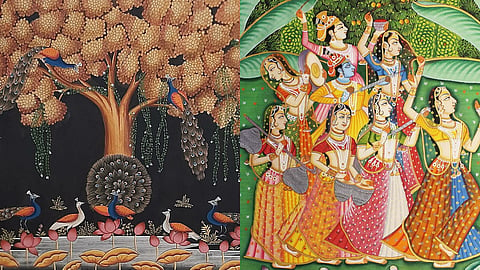
- HOMEGROWN WORLD
- #HGCREATORS
- #HGEXPLORE
- #HGVOICES
- #HGSHOP
- CAREERS
- ABOUT US
- CONTACT US

At the intersection of creativity and devotion, lies the ancient artistic tradition of Pichhwai. The word 'pichhwai' has Sanskrit roots and literally means 'that which hangs from the back'. The word is an amalgamation of the Sanskrit words pichh which means ‘back’ and wais which means ‘hanging’. The 400-year-old art form has large sacred Hindu images, primarily on cloth, portraying Lord Krishna. This beautiful art form was born in the vibrant town of Nathdwara, Rajasthan. It is renowned not just for its Shrinathji (Krishna) temple but also for the traditional Pichhwai artists living there since the 17th century. These gifted artists are responsible for bringing this uniquely divine art form to the rest of the world.
These vibrant cloth paintings adorn the rear walls of the Vallabha Sampradaya (sect) shrines. Vallabha Sampradaya, also known as Pushtimarg Sampradaya is an early 16th-century devotional school of thought, dedicated to worshipping Shrinathji. Shrinathji is the svarup (form) of Lord Krishna, resembling his 7-year-old infant self. The paintings hang behind the various svarups of Krishna worshipped by the sect and thus the term 'Pichhwai'.
The paintings are more than a decorative backdrop, however. It is an essential element of a highly developed seva (service) practices to Lord Krishna, creating a particular bhaav (mood), The paintings, with their bold and evocative compositions often recreate Krishna’s lilas (sports) or capture a reverential historic event. They are also a vital part of festivals in Nathdwara, where the liturgical calendar is loaded with festivals for the living child god, Shrinathji. Along with the festival pichhwais, there are painted works sponsored by the tilkayat (hereditary leader of the sect) to record historic occasions such as his personal offering of aarti to Shrinathji or a congregation of the svarups (living images).
The history behind how the bustling town of Nathdwara became the epicenter of the pichhwai tradition, is quite interesting. In 1671, the svarup of Shrinathji was transferred to Nathdwara from its original temple on Mount Govardhan in the Braj region (present-day Uttar Pradesh). This transfer was done in anticipation of a Mughal raid, led by Emperor Aurangzeb. They decided to bring it to Rajasthan, where it would be safe under the protection of the Rajputs. The svarup of Krishna was also accompanied by the lord's sevaks (servants) — the priests, halwais (confectioners), cows, and their caretakers, and the painters. They could not be live separately from Lord Krishna and came along to serve him — so true-hearted was their devotion.
After the transfer to Nathdwara in 1671 till the present-day, painted pichvais continue to be created by a handful group of hereditary artists in Nathdwara. It is believed that Lord Krishna permeates their thoughts and guides their paintbrushes. Painted pichhwais are never hung in winter but are hung only during the warmer months. In the gruelling heat of summer, the major themes in the artworks are representations of vibrant greenery, shady caves, sparkling pools, and blooming lotuses rising from the invigorating waters of the river Yamuna. When the outside temperature rises, these refreshing representations bring comfort to Shrinathji.
In the current day and age, pichhwai has become the main export of Nathdwara. It is in heavy demand in foreign markets. The artists live mostly in the chitron ki gali (street of paintings) and chitrakaron ka mohallah (colony of painters) and are a close-knit community. Often a pichhwai painting is a collaborative group effort, where several highly skilled painters work together under the supervision of a master artist. Many artists and designers from across the country have taken initiatives to preserve and showcase this art form to a wider, global audience. Designers have drawn inspiration from the traditional colors, printing techniques, and pattern styles associated with pichhwai in clothing attires and have showcased them via major international platforms such as Lakmé Fashion Week.
The pichhwai tradition has been nurtured for the last few centuries and prospered primarily because of the intimate and mutually beneficial relationship between the temple, its rich patrons, and its pilgrims, who come from diverse backgrounds. For artistic traditions with such a rich heritage, new patrons must come forward to ensure their continued flourishment.
If you enjoyed reading this, here's more from Homegrown:
How A Team Of Women From Kerala Defied Dogma To Paint A Kozhikode Temple
A Brief History Of Raagmalas: Ancient Miniature Paintings Inspired By Indian Classical Ragas
The World’s First Granite Temple: Brihadeshwara Temple in Tamil Nadu Is An Architectural Phenomenon
